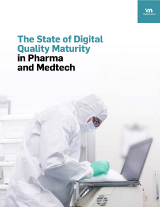
GxP Lifeline
3 Steps to Compete in Digital Quality Management

Last year, we set out to understand how digital transformation initiatives are affecting quality management maturity. Our original research showed that digital quality management still has a long way to go. To help you use this research to your advantage and get ahead of the competition, we recently released a webinar, “Winners Only: 3 Steps to Compete in Digital Quality.” During the webinar, MasterControl Senior Vice President of Go-to-Market Strategy Marty Smyth and Senior Product Manager Jessica Madsen discussed the research findings and three ways to use the information to get ahead.
MasterControl’s 2022 Digital Quality Management Maturity Study
Our research surveyed 152 quality professionals in multiple life sciences industries that work in companies ranging from startups to multinational corporations.
The presentation included some findings that surprised us. “Even though over 85% of our respondents claimed they had some form of quality management system, the key pain points continue to be around manual and paper processes,” Madsen said. This is likely tied to the fact that less than a third of companies that have an electronic quality management system (eQMS) have it implemented at all sites.
To help respondents determine the maturity of their digital quality management, we created a quality management maturity model. Smyth explained, “We wanted to include a model in this research so organizations could do a couple of things … we wanted them to have a clear framework by which they could evaluate where they are today, a progression to see where they wanted to be in the future and then to ask them what they need to accomplish to get from point A to point B.”
The quality management maturity model includes four tiers:
- Manual - We use paper for everything. Our idea of digital quality management involves opening a Word doc and analyzing data in Excel.
- Digital - We have an eQMS that connects some of our quality processes, but there’s no connection between other enterprise systems.
- Connected - We have an advanced eQMS that lets us integrate with other enterprise systems, giving us a unified data layer.
- Intelligent - We use advanced analytics and artificial intelligence (AI) to proactively improve quality.
No matter where a company falls in the quality management maturity model, they can used increased digitization as a way to compete.
3 Steps to Compete in Digital Quality Management
#1 Maximize Benefits
The first step is to focus on benefits and getting the most out of digital systems. The most popular reason respondents had for digitizing was to use it as a competitive advantage. In our survey, 58% of respondents said this was a major driver toward digital quality management maturity.
“The vast majority of respondents really look at this from a top-line business perspective. The more digital they can make the processes, the more connected they can get the data, they can drive more intelligence into their decision-making and their operations. That will create a competitive advantage,” said Smyth.
#2 Overcome Quality Management Blockers
One of the reasons it’s so important to focus on benefits is that there are always things holding companies back from increasing quality management maturity. And these can be legitimate concerns. The highest three blockers in our survey came down to cost, time, and disruption. With the right vendors, these blockers can be minimized to the point that they’re no longer a significant problem.
During the webinar, Madsen mentioned that we designed an assessment based on the research results. This assessment helps you rate your digital quality management and tells you which tier you fall into, but it also gives you specific help on how to overcome the biggest blocker in your organization.
#3 Prepare for the Future
MasterControl’s research includes where respondents thought their organization was on the quality management maturity model, but we also asked where respondents thought the industry as a whole was. Madsen explained that there was a significant difference between reality and respondents’ perceptions.
Even companies that are advanced in their digital quality management can’t afford to relax their efforts. We also asked where respondents expect to be in five years, and the vast majority expect to move up at least one tier. An ambitious 17% of the respondents in the manual tier think they can progress to the intelligent tier in that time. Advances in technology, particularly in eQMS solutions, make acting right now essential to keeping up with the competition.
These were just some of the key takeaways from our research. For more information read the report, “The State of Digital Quality Maturity in Pharma and Medtech.”
Free Resource

Enjoying this blog? Learn More.
The State of Digital Quality Maturity in Pharma and Medtech
Download Now